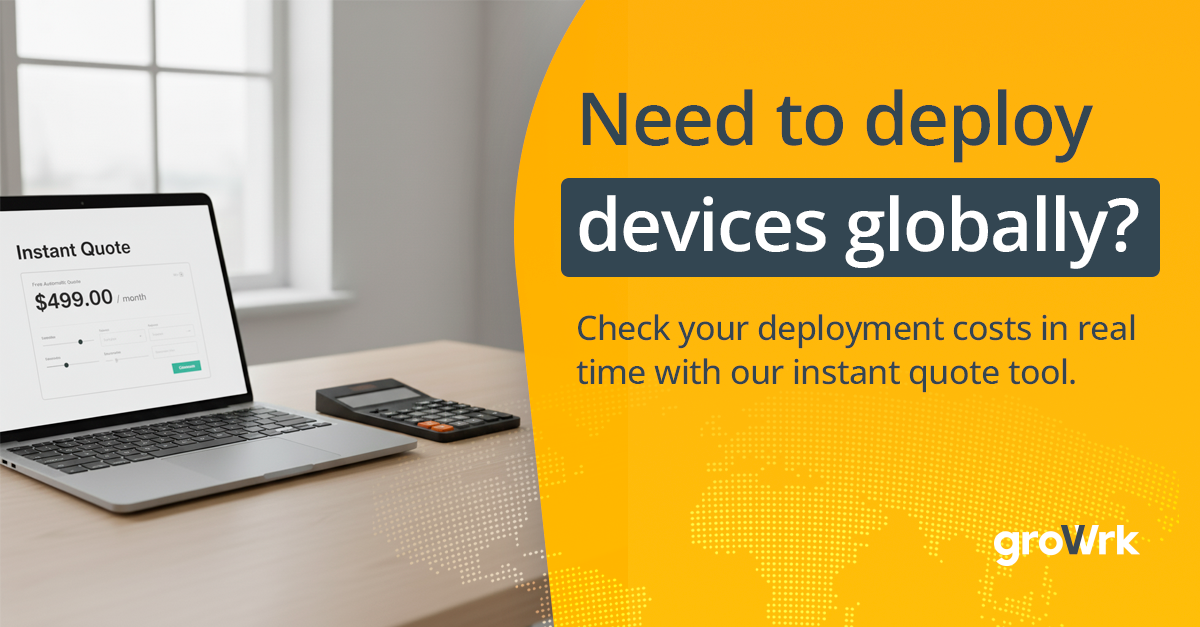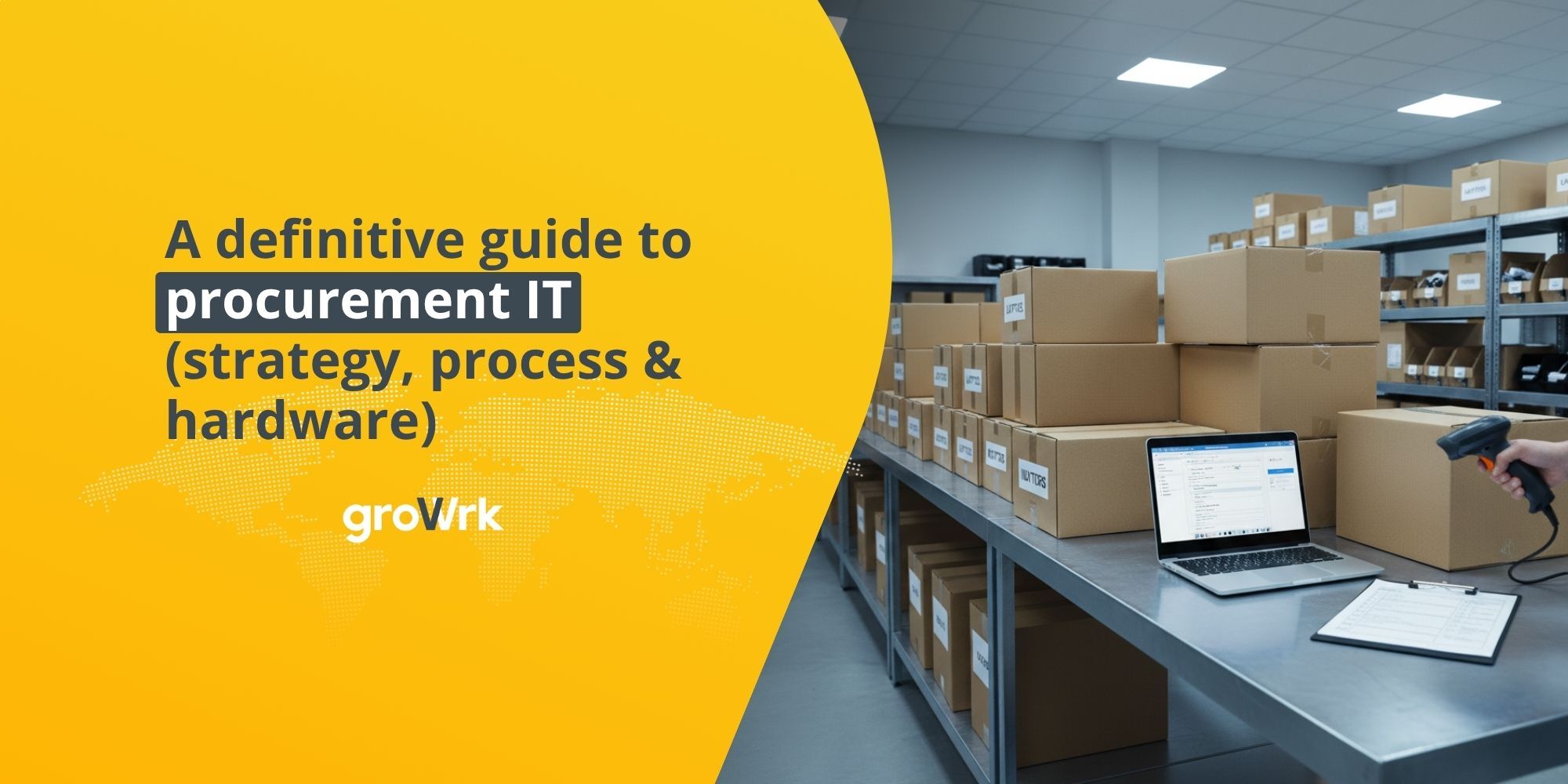How to avoid delays in IT procurement: essential tips and strategies
 GroWrk Team
GroWrk Team
Delays in IT procurement might seem like one-off mishaps—an overlooked email, a late shipment, a vendor bottleneck. But for distributed teams, they’re more than just inconveniences. Every delay disrupts onboarding, stalls productivity, and creates friction between IT, operations, and end users.
Procurement inefficiencies don’t just affect internal workflows—they directly impact customer satisfaction. If your employees don’t have the tools they need, when they need them, the downstream effect is felt by your customers next.
This guide outlines the reasons for delays, their origins, and how to address them through structured planning, intelligent automation, and improved communication with suppliers. Whether you're managing IT for five locations or fifty, a smoother procurement process starts here.
Key takeaways
-
Understanding and mapping out the IT procurement process is essential for identifying inefficiencies and preventing delays.
-
Effective planning, including the use of automation and regular schedule updates, is crucial for adhering to timelines and managing tasks efficiently.
-
Streamlining communication and utilizing technology for purchase order automation and supplier performance monitoring can enhance the procurement process and mitigate risks.
Understanding the procurement process

IT procurement involves more than just purchasing devices—it’s a coordinated series of steps that include planning, sourcing, configuring, and delivering equipment across a distributed workforce. Delays often stem from treating procurement as a transactional task rather than a strategic workflow.
A typical end-to-end IT procurement process includes:
-
Needs identification: Often triggered by a new hire, project launch, or hardware refresh cycle.
-
Budget and approval: Internal authorization for spending, sometimes with finance or legal involvement.
-
Vendor selection and sourcing: Identifying preferred suppliers and assessing delivery capabilities.
-
Purchase and configuration: Placing orders and preparing devices with the right software and security settings.
-
Delivery and onboarding: Shipping hardware to the correct location and ensuring it’s ready for day-one productivity.
-
Asset tracking and documentation: Logging ownership, warranties, and usage for compliance and lifecycle visibility.
Where things go wrong:
-
Orders are placed too late or only after an employee starts.
-
IT and HR systems don’t sync, so provisioning gets triggered manually.
-
Sourcing is centralized, creating long shipping times for remote regions.
-
There's no visibility into inventory or current order statuses.
Mapping out this process clearly—step by step—helps IT teams spot and eliminate delays before they cascade into missed onboarding dates and frustrated employees.
Get an instant quote
Why provisioning delays are more common than you think
IT leaders often treat shipping delays as bad luck or isolated incidents—an order gone wrong, a customs hiccup, or a missing serial number. But in today’s distributed world, delays are no longer anomalies. They’re the result of systemic breakdowns in how most organizations provision IT equipment.
| Common source of delay | What causes it | Why it matters |
|---|---|---|
| Global shipping disruptions | Port backlogs, container shortages, fuel price spikes, and transit delays | Even on-time vendor shipments can be delayed mid-route due to unpredictable logistics |
| Local customs issues | Changing import rules, missing paperwork, regional certifications | Triggers multi-week hold-ups and requires local compliance knowledge |
| Inventory gaps and system silos | HR, IT, and procurement teams use disconnected systems | Leads to last-minute orders, missed onboarding windows, and visibility breakdowns |
Public procurement regulations
Public procurement regulations exist to ensure that government and publicly funded contracts are awarded fairly, transparently, and efficiently. For IT procurement teams, especially those working with public institutions or international markets, compliance with these regulations is non-negotiable.
Here’s what you need to know:
-
Regulatory frameworks vary by region: Procurement laws differ across countries, with specific rules around planning, solicitation, vendor evaluation, and contract awards. Failure to comply can lead to disqualified bids, legal penalties, or loss of funding.
-
Transparent documentation is mandatory: Every solicitation document must clearly outline evaluation criteria, deadlines, and requirements. Using local templates or government-issued forms helps ensure compliance and consistency.
-
Planning ahead reduces legal risk: Teams should begin regulatory reviews early in the procurement cycle. This includes identifying applicable thresholds, required disclosures, and documentation formats.
-
Fairness is a compliance priority: Public tenders must be open and non-discriminatory. Clear communication, equal opportunity for bidders, and documentation of every decision point are essential to meet audit standards.
Pro tip: Work with legal or compliance advisors early when bidding for public sector contracts, and always align documentation with the specific jurisdiction’s requirements.
Hardware provisioning checklist: how to avoid shipping delays
Below is a comprehensive checklist to help your IT team streamline provisioning and minimize delays. Each step is designed to address a specific friction point in the global provisioning process.
1. Effective Planning and Scheduling
.png?width=600&height=300&name=avoid%20delays%20in%20it%20procurement%20(1).png)
-
Use digital calendars and task reminders to initiate procurement early.
-
Build in buffer time to accommodate supply chain fluctuations or internal approval delays.
-
Review and adjust the schedule regularly based on shifting timelines.
-
Identify task dependencies to avoid downstream blockers.
Pro tip: Use procurement software to estimate lead times based on historical delivery performance.
2. Prepare comprehensive solicitation documents
-
Include both administrative and technical requirements clearly.
-
Follow jurisdiction-specific language and compliance rules.
-
Allow at least two months for suppliers to respond with accurate bids.
-
Include evaluation criteria and scoring methods to ensure transparency.
Pro tip: Use pre-approved templates to streamline document creation and reduce revision cycles.
3. Streamline communication with suppliers
.png?width=600&height=300&name=avoid%20delays%20in%20it%20procurement%20(2).png)
-
Centralize communication in one procurement platform.
-
Share updates proactively—especially around potential delays.
-
Use simple language in contracts to avoid confusion or misinterpretation.
-
Build long-term relationships with regular check-ins, not just transactional touchpoints.
Pro tip: Track vendor responsiveness as a KPI—it’s often a leading indicator of fulfillment quality.
4. Automate purchase order creation
-
Eliminate manual PO entry with automated workflows.
-
Reduce human error and duplicate requests.
-
Prevent unauthorized purchases through centralized approval routing.
-
Sync orders directly with inventory and finance systems.
Pro tip: Use dynamic forms and dropdowns to pre-validate PO fields before submission.
5. Monitor supplier performance
-
Define clear KPIs like on-time delivery, accuracy rate, and responsiveness.
-
Use supplier scorecards to evaluate and compare vendors objectively.
-
Meet regularly to review performance trends and areas for improvement.
Pro tip: Incorporate supplier metrics into your quarterly IT performance reviews.
6. Manage inventory levels proactively
.png?width=600&height=300&name=avoid%20delays%20in%20it%20procurement%20(3).png)
-
Use real-time dashboards to monitor stock availability across regions.
-
Set automated reorder points to avoid stockouts.
-
Place advance orders when onboarding surges are expected.
Pro tip: Use historical usage patterns and headcount forecasts to refine inventory thresholds.
7. Address external factors and risks
-
Track regional holidays, customs trends, and regulatory changes.
-
Build contingency buffers into shipping timelines for higher-risk regions.
-
Diversify suppliers and warehouse locations to mitigate disruption impact.
Pro tip: Create a shared calendar of local events and known customs holidays to improve shipment planning.
8. Implement real-time tracking systems
-
Use tools like RFID, GPS, or cloud-based logistics software for shipment updates.
-
Integrate tracking data into your IT dashboard for full visibility.
-
Set up alerts for delays or deviations from SLA timelines.
Pro tip: Choose logistics partners who offer full last-mile visibility.
9. Optimize approval workflows
-
Use workflow automation to move approvals quickly through procurement.
-
Assign clear ownership and escalation paths.
-
Define SLA expectations for each approval stage to reduce waiting time.
Pro tip: Conduct a quarterly audit of approval bottlenecks and adjust policies as needed.
10. Leverage technology for risk mitigation
-
Use AI tools to flag risk factors like vendor lead time changes or pricing volatility.
-
Simulate “what-if” scenarios during procurement planning.
-
Track risk indicators alongside procurement KPIs.
Pro tip: Use machine learning to analyze risk signals in vendor emails and proposal documents.
11. Continuous improvement in procurement operations
.png?width=600&height=300&name=avoid%20delays%20in%20it%20procurement%20(4).png)
-
Run post-mortems on delayed shipments to find root causes.
-
Use analytics dashboards to track procurement efficiency and cost savings.
-
Keep teams upskilled with regular training on tools and vendor compliance.
Pro tip: Encourage IT, procurement, and finance to co-own provisioning KPIs for better alignment.
Key performance indicators for procurement
Tracking key performance indicators (KPIs) is essential to evaluate the effectiveness of your procurement operations and identify areas for continuous improvement. The right metrics help procurement teams monitor performance, spot inefficiencies early, and make data-driven decisions that improve speed, cost control, and supplier reliability.
Here are the core KPIs to monitor:
| KPI | What it measures | Why it matters |
|---|---|---|
| Procurement cost savings | Reduction in spend through negotiation, bulk buying, or process efficiency | Indicates how well your team controls procurement expenses |
| Procurement cycle time | Time from purchase request to order fulfillment | Highlights bottlenecks that delay onboarding or project launches |
| Supplier lead time | Average time suppliers take to deliver after receiving an order | Helps evaluate supplier reliability and forecast delivery timelines |
| On-time delivery rate | Percentage of orders delivered within agreed timeframes | Key to maintaining project schedules and employee satisfaction |
| Purchase order accuracy | % of POs that are correct and require no rework | Minimizes errors that delay shipments or require extra coordination |
| Inventory turnover | How quickly inventory is used or replaced | Indicates whether stock levels are aligned with real demand |
| Supplier performance score | Composite score based on delivery, responsiveness, and quality | Enables strategic supplier management and vendor accountability |
Pro tip: Track procurement KPIs monthly and review them quarterly with IT and finance stakeholders. This builds cross-functional accountability and uncovers trends that may not be obvious in day-to-day operations.
Common pitfalls to avoid
While the checklist above can prevent most delays, it’s equally important to avoid the common traps that trip up even experienced IT teams. Profit margins are crucial in relation to inventory management and overall financial health, as prolonged warehousing and cash flow issues can negatively affect these margins by increasing costs and tying up capital:
| Pitfall | Why it happens | How to avoid it |
|---|---|---|
| Over-reliance on a central warehouse | Global shipments face customs delays and longer delivery times | Distribute inventory across regional hubs to shorten lead times |
| Ignoring local holidays and import restrictions | Lack of region-specific planning causes surprise delays | Maintain a regional calendar for every shipping zone |
| Skipping address validation | Incomplete or incorrect addresses result in failed deliveries | Automate address verification at the point of order |
| No end-of-life asset retrieval plan | Old devices accumulate without a reverse logistics process | Build asset recovery into your provisioning lifecycle (incl. secure wiping) |
| Treating provisioning as secondary | IT prioritizes onboarding but not logistics | Make provisioning a dedicated, resourced IT function, not an afterthought |
Takeaway: Avoiding these pitfalls not only speeds up procurement but also improves inventory accuracy, employee satisfaction, and overall IT operations.
Missed deadlines and consequences
Missed deadlines can have significant consequences for organizations, including delayed projects, increased costs, and reduced customer satisfaction. To avoid missed deadlines, procurement teams must ensure that all stakeholders are informed and involved in the procurement process.
| Consequence | What it looks like | Business impact |
|---|---|---|
| Delayed onboarding | New hires arrive without devices or credentials | Lost productivity, poor first-day experience |
| Project slowdowns | Teams can’t start or complete deliverables on time | Revenue delays, missed milestones |
| Increased costs | Rush shipping, emergency purchases, idle equipment | Budget overruns and poor cost control |
| Customer dissatisfaction | Late delivery of services or missed SLAs | Eroded trust, potential churn |
| Internal friction | Frustration between IT, HR, Ops, and Finance | Reduced cross-team alignment and morale |
Takeaway: Every missed deadline sets off a chain reaction. Keeping procurement on track protects productivity, budgets, and your company’s reputation.
Human error and prevention
Human error is a common cause of delays and mistakes in the procurement process. To prevent human error, procurement teams must implement processes and systems that minimize the risk of mistakes.
| Common error | Example scenario | How to prevent it |
|---|---|---|
| Manual data entry mistakes | Incorrect shipping address or PO number entered | Use automated forms with field validation |
| Missed approvals | PO sits idle in someone’s inbox | Set up automated approval workflows with reminders |
| Unclear responsibilities | Confusion over who owns procurement for a new hire | Define RACI (Responsible, Accountable, Consulted, Informed) roles early |
| Duplicate orders | Two teams unknowingly order the same equipment | Centralize procurement and use tracking software |
| Inconsistent documentation | Solicitation documents missing key compliance details | Use standardized templates and a review checklist |
Takeaway: Automating repetitive tasks, setting up clear workflows, and assigning ownership can dramatically reduce preventable errors—and keep your procurement engine running smoothly.
How GroWrk eliminates IT procurement delays
GroWrk takes the complexity out of global IT provisioning. Whether you're onboarding employees across five cities or fifty countries, our platform handles every step—from procurement to delivery—with speed, visibility, and zero guesswork.
-
Local warehousing in key regions
Avoid long customs delays and unpredictable shipping timelines by sourcing devices closer to your team. -
Pre-configured, company-ready devices
Every device is imaged, security-configured, and asset-tagged before it ships—so new hires are productive from day one. -
Automated order workflows
Integrate with your HR and IT systems to trigger device procurement automatically when a new employee is added. -
Live tracking and SLA transparency
Monitor every shipment through GroWrk’s dashboard, with real-time updates, delivery timelines, and service level adherence. -
Built-in compliance for every region
We handle customs paperwork, regional electrical standards, and import regulations—ensuring smooth delivery, every time. -
Asset recovery and secure disposal
Reclaim unused devices with our global pickup network. Choose between redeployment, certified recycling, or resale. -
Centralized procurement reporting
View procurement costs, track asset usage, and analyze delivery performance across all your locations from one platform.
Ready to cut procurement delays from weeks to days? Schedule a demo and see how GroWrk streamlines device delivery worldwide.
Frequently Asked Questions
What is the main reason for delays in the procurement process?
The main reason for delays in the procurement process is inadequate planning, which often leads to a failure to start on time. Addressing this issue can significantly improve efficiency.
How can effective planning help avoid procurement delays?
Effective planning minimizes procurement delays by facilitating timely actions and enabling the accommodation of unforeseen challenges through tools like procurement software and electronic calendars. By proactively managing timelines and resources, organizations can significantly enhance their procurement processes.
Why are comprehensive solicitation documents important?
Comprehensive solicitation documents are vital as they offer clear guidelines and evaluation criteria, minimizing delays in bid preparation and evaluation. This clarity fosters a more efficient procurement process.
How does automating purchase order creation benefit the procurement process?
Automating purchase order creation enhances the procurement process by minimizing manual errors and ensuring accurate orders, which in turn accelerates overall efficiency. This leads to a more streamlined and reliable procurement system.
What role does technology play in risk mitigation during procurement?
Technology plays a crucial role in risk mitigation during procurement by utilizing AI and advanced analytics to identify and track potential risks effectively. This proactive approach enhances decision-making and improves overall procurement resilience.



.png)


